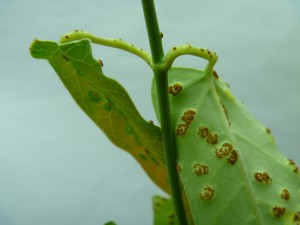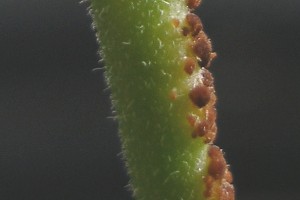Application to release moth plant rust

Image – Carolyn Lewis
The application for permission to release the moth plant rust, Puccinia araujiae (Pucciniaceae) was approved by the EPA. The decision can be found on EPA's website. This is the second of several biocontrol agents that will work together to help control moth plant in New Zealand.
Background
This application will be submitted by Northland Regional Council, acting on behalf of the National Biocontrol Collective, a consortium of regional councils and the Department of Conservation. The Collective funds the development of weed biocontrol programmes in New Zealand. Landcare Research is the science provider for this development. Landcare Research has contracted Richard Hill & Associates to prepare the application and to manage the application process on behalf of Northland Regional Council, including pre-application consultation with EPA and with Māori and other stakeholders.
In its native range of Argentina and Brazil, moth plant is considered to be an ornamental, industrial, and medicinal plant, but in its exotic range these benefits are heavily outweighed by its environmental impact. Moth plant climbs over shrubs and small trees, smothering and breaking them down. It also spreads over the ground, smothering small native plants and desirable seedlings. Moth plant therefore poses a high risk to peri-urban reserves and forests, overtopping and smothering trees, and replacing native vegetation. In time it will become more common outside of urban areas and will become an increasing threat to healthy native forests in northern New Zealand. Moth plant is known from intact and disturbed forest and margins, tracks,&nbs, p;coastline, cliffs, riparian margins, shrublands, mangroves, inshore and offshore islands; almost any frost-free habitat.
Both fruits and stems exude a caustic milky sap when broken. This white latex is sticky, and causes skin irritation in susceptible people. The sap can also cause eye irritation. The latex is poisonous to humans (Landcare Research accessed 2011) and ingestion of the foliage of Araujia hortorum can cause gastrointestinal symptoms such as nausea, vomiting and diarrhoea. Other plant parts including seeds have been reported as toxic to poultry and cattle in Australia, though it is not often eaten and cases of poisoning are not common.
For more information about moth plant see:
- Ecology and pest status of moth plant
- Reported distribution of moth plant (map prepared by DOC based on various electronic datasources and expert opinion)
The moth plant rust is the second agent to be developed for this weed. EPA approved the release of the beetle Colaspis argentinensis in December 2011. The larvae of this beetle feed on the roots of the weed, and this attack will be complementary to the rust fungus which will damage the leaves. The beetle has not yet been released because of difficulties in obtaining a founding colony of insects from the country of origin, Argentina.
Identification and assessment of risks, costs and benefits

Puccinia araujiae pustules on moth plant leaves and stems
The potential risks, costs and benefits resulting from biological control of moth plant were addressed fully in 2011 when the application to introduce Colaspis argentinensis was presented. The same information will be provided to EPA in this application.
The potential risks, costs and benefits resulting from the introduction of moth plant rust have been formally identified and will be addressed fully in the application.
The significant effects identified (highlighted in yellow) will be addressed in detail in the application:
- Risks, costs and benefits of biocontrol of moth plant using moth plant rust
The key possible adverse effects of introducing the rust will be addressed fully in the application:
- the risk of direct damage to valued garden ornamentals, especially swan plant
- the risk of direct damage to native plants
- indirect effects on flora and fauna as a result of disruption of ecological relationships
Moth plant belongs to the sub family Asclepiadoidieae of the family Apocynaceae. This was previously a separate family Asclepiadaceae. There are no native species in this sub-family, and the application will present evidence that no native species will be at risk from this rust. Several ornamental species are related to moth plants, notably tweedia (Oxypetalum caeruleum) and swan plant (Gomphocarpus fruticosus, G. physocarpus and Asclepias curassavica). These plants are particularly valued by those fostering butterflies such as Monarchs. Tests indicate that the rust should not attack the two species of swan plant tested (G. fruticosus and A. curassavica). It was not possible to test tweedia so this plant could be at risk from incidental infection by this rust. Tweedia also proved marginally acceptable to the first control agent considered, Colaspis argentinensis. The social and economic costs associated with possible attack on tweedia were canvassed and addressed in the previous application, and in the EPA decision. The results of that consultation will be repeated in this application.
Because the rust disease is almost completely host specific, population densities capable of interacting significantly with other plants or animals will only be found in close proximity to moth plant. As a result, no significant disturbance of ecological relationships is expected in New Zealand. Mechanisms for interaction are limited.
Pre-application consultation with Iwi
Applications to introduce control agents against seven weeds will be submitted over the next 18 months. The members of the EPA 's national network Te Herenga will be contacted in August 2014, and invited to enter dialogue on the National Biocontrol Collective's plans to apply to EPA to introduce biological control agents to attack these weeds.
The message to Te Herenga will describe how the applicant intends to assess the risks, costs and benefits associated with the proposed introductions. Members will be invited to identify any issues that they would like to be addressed in the applications. In order of application, the target weeds are Privet, Japanese honeysuckle, moth plant, lagarosiphon water weed, old man’s beard, wild ginger and field horsetail. Three targets (Japanese honeysuckle, moth plant, old man’s beard) have been the subject of previous successful applications, and consultation was completed in each case. The outcome of previous consultations will be presented.
At the request of the applicant, EPA will convene a reference group from Te Herenga to meet and discuss the issues surrounding the proposed applications.
Members of Te Herenga will be informed by EPA when each application is open for public submission, and will be able to comment on how the applicant has addressed issues raised during consultation.
Responses relevant to the biological control of moth plant are summarised here:
Pre-application consultation with other organisations
Other organisations consulted were:
- Nursery and Garden Industry New Zealand
- Regional Councils
- Royal Forest and Bird Protection Society of New Zealand
- Department of Conservation staff
- QEII National Trust
- NZ Landcare Trust
The responses received from other organisations are summarised here:
Key documents
Reports on host-range determination
Safety issues are paramount in the minds of biocontrol of weeds researchers. Researchers rigorously test all proposed agents to assess the risk of damage to non-target plants. A set of procedures helps researchers choose a suitable shortlist of test plants, and this methodology is now well-accepted internationally (Wapshere, 1974). The technique is under constant review to update best practice (e.g. Sheppard et al., 2005; Briese, 2005).
The results of host range testing conducted on the moth plant rust will be fully discussed in the application. A detailed report on these results can be found here:
The unpublished report by will be peer reviewed and that review will be provided to EPA.
An inital report can be found here:
- Initial report on methodology for host-range testing of the moth plant rust, Puccinia araujiae
The feasibility of biological control of moth plant in New Zealand was investigated for several Regional Councils and a survey of the invertebrate fauna and fungi associated with moth plant in New Zealand was carried out by Landcare Research.
- Prospects for biological control of moth plant
- Invertebrates and Fungi Associated with moth plant in New Zealand
Cited references
Wapshere AJ (1974) A strategy for evaluating the safety or organisms for biological weed control. Annals of Applied Biology 77: 201–211.
Briese D (2005) Translating host-specificity test results into the real world: The need to harmonize the yin and yang of current testing procedures. Biological Control 35: 208–214.
Sheppard AW, Heard TA, van Klinken RD (2005) Scientific advances in the analysis of direct risks of weed biological control agents to non-target plants. Biological Control 35: 215–226.
Downloadable content & links
- pdf Ecology and pest status of moth plant, Araujia hortorum Fournier pdf File, 179 KB
- pdf Experimental determination of the host range of Puccinia araujiae Lév. (Pucciniaceae) pdf File, 344 KB
- pdf Prospects for biological control of moth plant, Araujia hortorum Fournier pdf File, 165 KB
- pdf Public consultation and risk assessment for the proposed introduction of Colaspis argentinensis as a biological control agent for moth plant pdf File, 309 KB
- pdf Reported distribution of moth plant pdf File, 2.5 MB
- pdf Responses to public consultation on the proposed introduction of two biological control agents for moth plant pdf File, 1 MB
- pdf Summary of Iwi responses to pre-application consultation pdf File, 164 KB
- pdf Surveys for potential biocontrol agents for moth plant in New Zealand and Argentina pdf File, 71 KB


